Cold Temp Telescope Tips, Pre-dawn Planets, Lunar Libration Shows Seas, and the Waxing Moon Passes the Football!
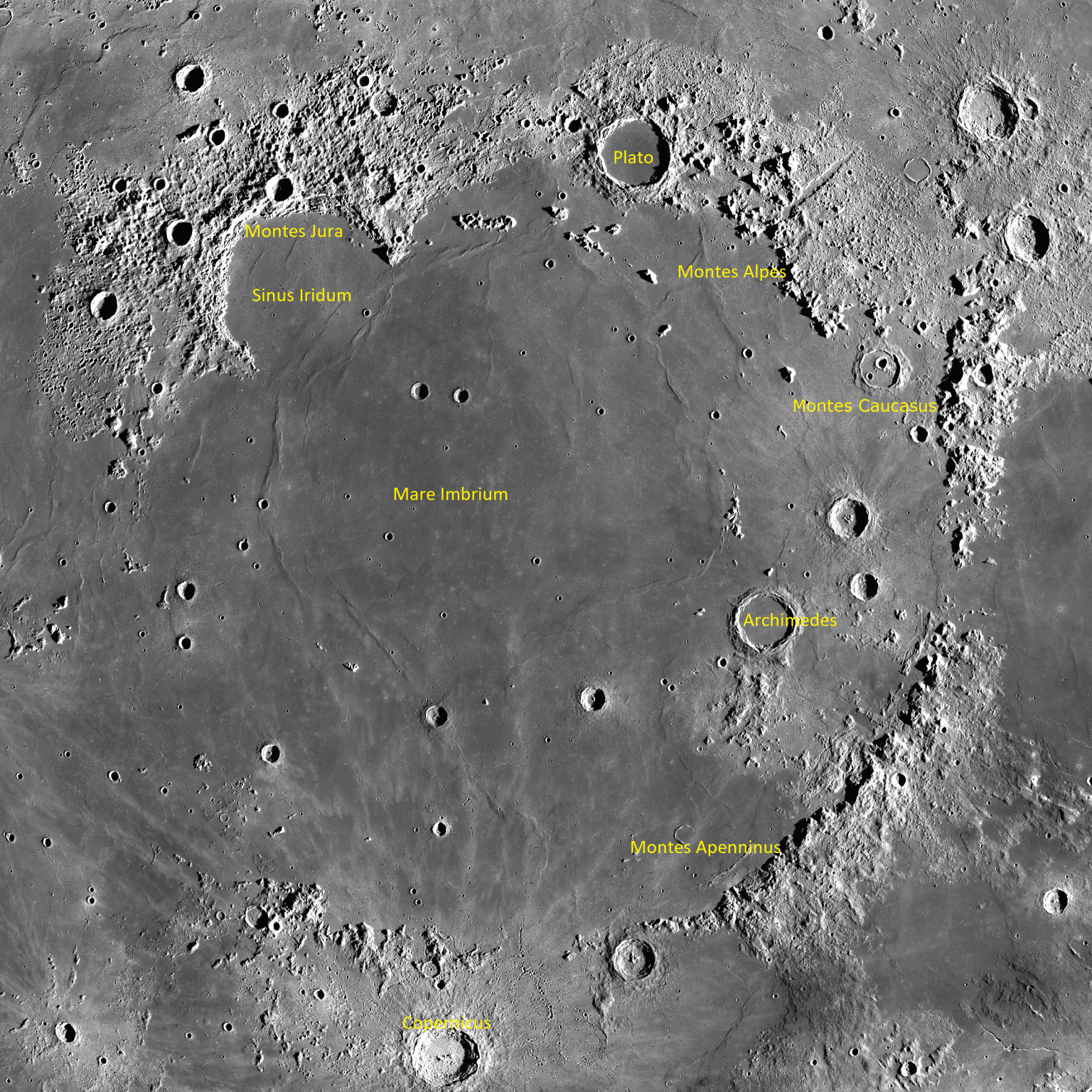
This image from the Lunar Reconnaissance Orbiter shows the entire Mare Imbrium region. On Thursday and Friday this week, the terminator will bisect the huge region, casting in stark relief the ringed mountain ranges to the east: Montes Alpes, Montes Caucasus, and Montes Apenninus. On Saturday night, the terminator will highlight the curved Montes Jura flanking Sinus Iridum (top left). The crater Copernicus is at bottom centre. Adapted from Wikipedia, LRO
Hello, mid-winter Stargazers!
Here are your Astronomy Skylights for the week of February 6th, 2022 by Chris Vaughan. Feel free to pass this along to your friends and send me your comments, questions, and suggested topics. You can also follow me on Twitter as @astrogeoguy! Unless otherwise noted, all times are expressed in Eastern Time. To subscribe to these emails please click this MailChimp link.
If you’d like me to bring my Digital Starlab portable inflatable planetarium to your school or other daytime or evening event, or deliver a session online, contact me through AstroGeo.ca, and we’ll tour the Universe, or the Earth’s interior, together! My terrific new book with John A. Read entitled 110 Things to See With a Telescope is a guide to viewing the deep sky objects in the Messier List – for both beginners and seasoned astronomers. DM me to order a signed copy!
There will be plenty of sights to see on the waxing moon this week, including some elusive edge features. The moon will play some football at week’s end. Meanwhile, Jupiter sinks lower after sunset, and Mercury joins Venus and Mars before sunrise. I also share some tips for using telescopes in extreme cold. Read on for your Skylights!
Telescope Tips for Cold Weather Observing
Even if you live where it’s extremely cold outside, you can still use your telescope if you follow some best practices.
Your telescope will work much better if you allow it to cool down to the ambient air temperature for an hour or two before you head outside. That way, the glass in the lenses and mirrors can reach a uniform temperature. Any turbulence arising from the warm air trapped inside the telescope churning while it chills to match the cold metal of the tube will also have time to die down.
Larger telescopes need more cooling time. Have the telescope set up, with the lens caps on, while you wait – and ensure that your equipment is somewhere secure, such as the backyard or deck, unheated garage, or the trunk of your car. If you forget to set the telescope out in advance, you can still use it. The views should improve as time goes on.
While you are waiting, consider making a plan of what you’ll look at. Account for when the object rises high enough to see it, and in which direction it will be situated. You can even work out a viewing sequence. That way, you’ll see your targets faster, and get back to the hot cocoa sooner. By the way, alcohol degrades visual acuity – so consider waiting until hot cocoa time to consume any of it.
If the images seem dim, check the glass of the eyepiece and the objective lens or mirror. They may be fogged up or frosted over. You can clear that off by gently waving a hair dryer set to Cool over the lens. Don’t hold the blower too close to the glass, though. When not using your eyepieces, put something over them, or perhaps tuck them into a pocket or a fishing tackle box. You can try to hold your breath (only while viewing, of course) to avoid warm breath fogging your eyepieces.
If you expect your telescope objective lens tends to frost up, you can make a dew/frost shield for it. Roll up some heavy paper, a plastic school folder, or some rubber/foam sheeting and affix it around the front of your telescope tube with elastic bands. It only needs to extend forward by about the diameter of the telescope tube. Another trick is to attach a hand warmer pouch to the underside of the telescope tube near the objective lens.
Speaking of hand-warmers, always dress for much colder than you expect. You’ll potentially be standing around a lot – on cold ground. Those warmers, either chemical or electric, are great to tuck into boots and gloves.
Before bringing everything back inside, re-install the caps and, if possible, zip the telescope into its case. That will cut down on the amount warm house air reaching your equipment and condensing as water or frost. A good alternative is to cinch a big plastic bag around the cold telescope and eyepieces. In the morning, open everything up, including removing the lens caps, and allow it to dry fully.
The Moon
This will be the best week of the lunar month for the moon-lovers among us! Our orbiting “mini-me” will rise during mid-day, and then shine prettily in the evening sky worldwide. Even the youngest stargazers can take a peek at the moon before bedtime – so dust off the binoculars and telescopes – any size will do. As the moon waxes through first quarter, the lunar terrain near the pole-to-pole terminator boundary will be dramatically lit by low-angled sunlight – with new vistas every night!
Due to the moon’s orbital inclination (or tilt) and the ellipticity (or out-of-roundness) of its orbit, the moon nods up-and-down and twists left-to-right up by to a half-dozen degrees while it keeps the same hemisphere pointed towards Earth. Over time, this lunar libration effect lets us see an extra 9% of the moon’s total surface, without leaving the Earth! Features that are smeared along the moon’s edge rotate into view on selected dates.
You can see libration’s effect on the moon at a glance by watching Mare Crisium “the Sea of Crises”. That’s the isolated, dark and round feature located near the right-hand (eastern) edge of the moon, just north of the moon’s equator. It becomes fully illuminated starting about four days after new moon each month. Whenever the waxing crescent moon is descending in the western sky after sunset, its eastern edge becomes tilted downwards, towards the lower right – making Mare Crisium a dark blob squarely within the illuminated crescent.
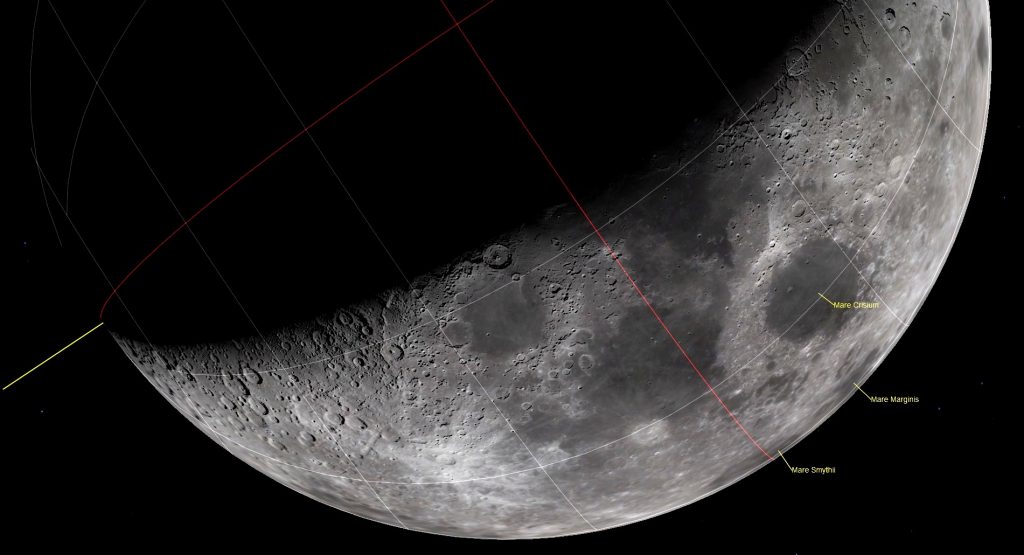
Tonight (Sunday), libration will shift Mare Crisium farther than usual from the moon’s edge. (Libration will still be working on Monday, too, albeit less.) Once you’ve spotted Mare Crisium, look nearby for two dark patches positioned closer to the moon’s edge. Those are maria named Mare Marginis, which is higher and closer to Mare Crisium, and Mare Smythii, which sits lower and therefore farther away. Those “seas” are difficult to see unless the moon’s eastern limb is rotated towards Earth.
After spending Sunday night librated in Pisces (the Fishes), the moon will hop east to shine among the stars of Aries (the Ram) on Monday night, and only two finger widths to the upper left (or 2° to the celestial southeast) of the planet Uranus. The moon’s bright light won’t do the magnitude 5.8 planet any favours, but you can still look for its blue-green dot by keeping the moon just out of sight in your binoculars. Several hours earlier, at around 19:39 Greenwich Mean Time, observers in the southern Atlantic Ocean near Queen Maud Land can see the moon pass in front of (or occult) Uranus. (More on Uranus below.)
The moon will complete the first quarter of its orbit around Earth at 8:50 am EST (or 13:50 GMT) on Tuesday. At that time, the relative positions of the Earth, sun, and moon will cause us to see our natural satellite exactly half-illuminated – on its eastern side. During the hours surrounding 17:30 GMT, the Lunar X and Lunar V phenomena will appear on the moon. I wrote about them here. The moon will be in the eastern daytime sky at the peak around 12:30 pm EST, but observers in Europe and Africa can see those features easily because the moon will be shining in a dark sky.
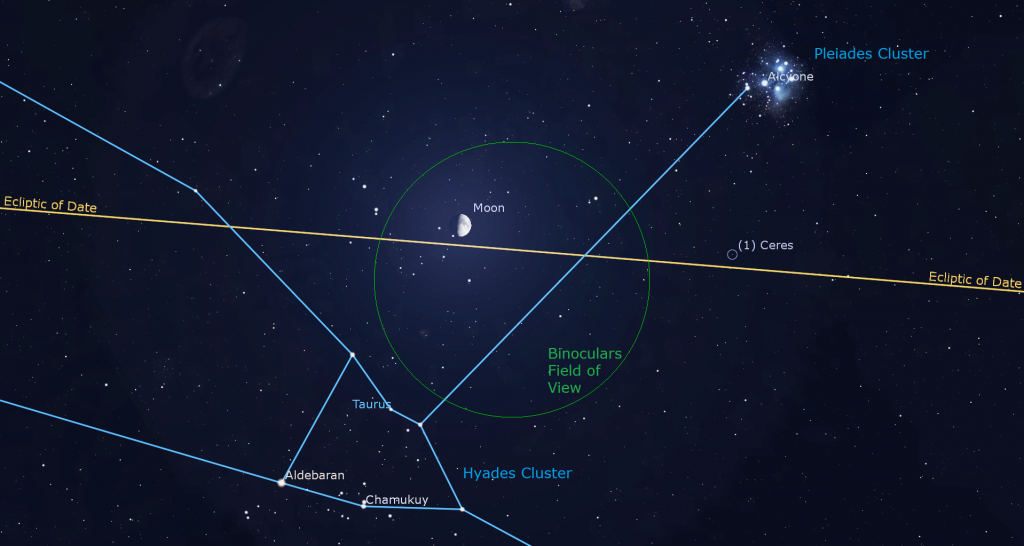
On Wednesday evening, the now waxing gibbous moon (i.e., more than half-illuminated) will cross between the stellar siblings of the Hyades and the Pleiades star clusters in Taurus (the Bull). The Hyades cluster (also known as Caldwell 41 and Melotte 25) forms the triangular face of Taurus. The bright, reddish star Aldebaran is parked at the lower left (southeasterly) corner, serving as the bull’s angry eye. The Hyades cluster is 11 times the diameter of the moon because it is one of the closest clusters to Earth – it’s only 147 light-years away. Aldebaran is only half as far away, and is not related to those stars.
In Greek mythology, the Hyades are daughters of Atlas – five sisters mourning the loss of their brother.
The stars in the bright little Pleiades star cluster, also called the “Seven Sisters”, and Subaru in Japan, are also daughters of Atlas and Pleione – and sisters to the Hyades. Many indigenous cultures have attached a special significance to the prominent Pleiades. Its stars are more than twice as far away as the Hyades – but both clusters were likely formed out of the same giant molecular hydrogen cloud.
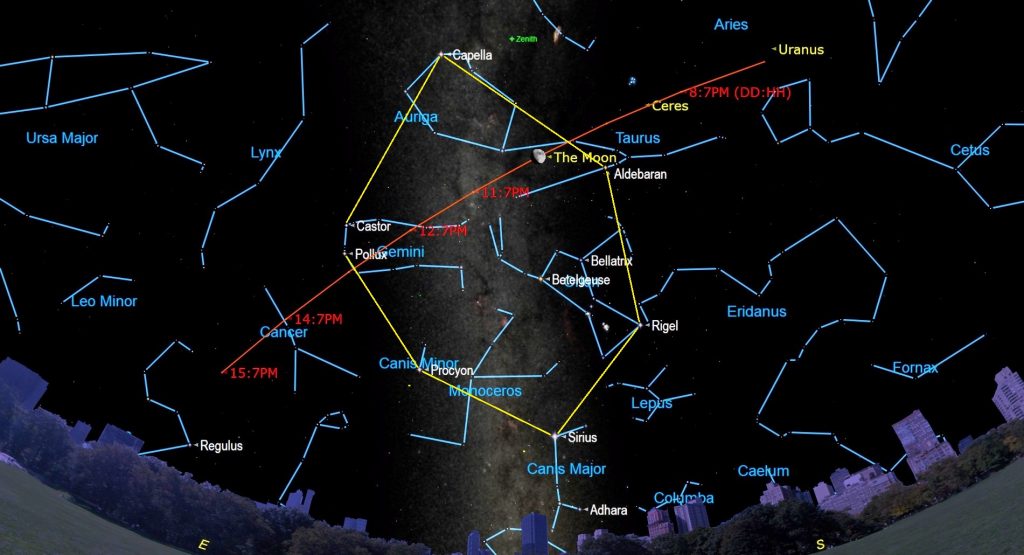
From Thursday to Saturday the bright moon will pass through the Winter Football – just in time for Superbowl Weekend! The Winter Football, also known as the Winter Hexagon and the Winter Circle, is an asterism composed of the brightest stars in the constellations of Canis Major (the Big Dog), Orion (the Hunter), Taurus (the Bull), Auriga (the Charioteer), Gemini (the Twins), and Canis Minor (the Little Dog). Clockwise from the bottom, the stars are Sirius, Rigel, Aldebaran, Capella (at the top), Castor & Pollux, and Procyon. Viewed after dusk from mid-Northern latitudes, the huge pattern stands upright in the southeastern sky – extending from about 30 degrees above the horizon to nearly overhead. The Milky Way passes vertically through the asterism. The hexagon is visible during evenings from mid-November to spring every year.
Thursday and Friday will be excellent nights to view the three impressive, curved mountain chains that encircle the eastern rim of dark Mare Imbrium. That giant impact basin, covering much of the north-central portion of the moon’s Earth-facing hemisphere, will be half in light and half in shadow. Those mountains, actually segments of the old crater rim, will be enhanced by slanted sunlight.
The most northerly arc of mountains is the Lunar Alps, or Montes Alpes. Binoculars or a telescope will show you a gash cutting through them called the Alpine Valley, or Vallis Alpes. It’s a rift valley, up to 10 km wide, where the moon’s crust has dropped due to faulting. To the lower right (lunar southeast) of the Alps are the Caucasus Mountains, or Montes Caucasus. This stubby, but high (up to 6000 metres tall) mountain range disappears under a lava-flooded zone connecting Mare Imbrium with Mare Serenitatis. The southeastern edge of Mare Imbrium has the lengthy Apennine Mountains, or Montes Apenninus. They sink out of sight near the prominent crater Eratosthenes, and the larger crater Copernicus beyond it.
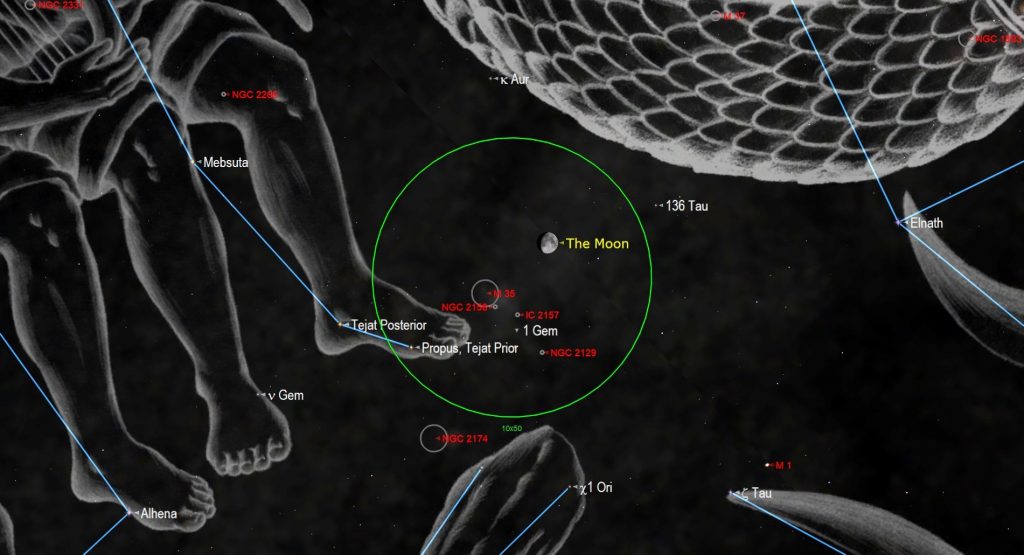
On Friday night, the orbital motion of the moon will bring it just to the north of the large and bright open star cluster in Gemini known as Messier 35, or the Shoe-Buckle Cluster, which sits near the bright toe-stars Tejat Posterior (Mu Geminorum) and Propus (Eta Geminorum). After full dark, when the cluster’s stars will become visible in binoculars, the moon will be poised two finger widths above (or 2.2 degrees to the northwest of) the cluster. By the time of their closest approach around 1 am Eastern Time, 10 pm Pacific Time or 6 GMT, the pair will be cosy enough to share the view in a backyard telescope. At that time, the diurnal motion of the sky will have shifted the moon to the upper right of the cluster. To better see the Shoe-Buckle’s stars, hide the moon just beyond the field of view of your binoculars or telescope.
On Saturday night, the terminator will fall to the left (or lunar west) of Sinus Iridum, the Bay of Rainbows. The circular, 249 km diameter feature is a large impact crater that was flooded by the same basalts that filled the much larger Mare Imbrium to its right (lunar east) – forming a rounded, handle-shape on the western edge of that mare. You can see it with sharp eyes – and easily in binoculars and backyard telescopes. The “Golden Handle” is produced when slanted sunlight brightly illuminates the eastern side of the prominent, curved Montes Jura mountain range that surrounds the bay on the top and left (north and west), and by a pair of protruding promontories named Heraclides and Laplace to the bottom and top, respectively. Sinus Iridum is almost craterless, but hosts a set of northeast-oriented dorsae or “wrinkle ridges” that are revealed under magnification at this phase.
The moon will spend the coming weekend partying with the twins. That will be a great time to look at the prominent crater Copernicus, located in eastern Oceanus Procellarum – which is due south of big Mare Imbrium and slightly northwest of the moon’s centre. Copernicus’ 800 million year old impact scar is visible with unaided eyes and binoculars – but telescope views will reveal many more interesting aspects of lunar geology. Several nights before the moon reaches its full phase, Copernicus always shows off its heavily terraced edges (due to slumping), an extensive ejecta blanket outside the crater rim, a complex central peak, and both smooth and rough terrain on the crater’s floor. Around full moon, Copernicus’ squiggly ray system, extending 800 km in all directions, becomes prominent. Use high magnification to look around Copernicus for small craters with bright floors and black haloes around them, created when impacts through Copernicus’ white ejecta blanket excavated dark Oceanus Procellarum basalt and even deeper highlands anorthosite.
The Planets
Once the sky begins to darken, at around 6 pm local time in mid-Northern latitudes, the bright dot of Jupiter will emerge from the twilight, sitting about a fist’s diameter above the west-southwestern horizon. You might need to walk around a little to find it between the trees and buildings. It will set at about 7 pm local time. Binoculars and small telescopes will show you the Jupiter’s four large Galilean moons named Io, Europa, Ganymede, and Callisto. Since Jupiter’s axial tilt is a miniscule 3°, those moons always look like beads strung on a line that passes through the planet, and parallel to Jupiter’s dark equatorial belts. The moons’ arrangement varies from night to night. Once Jupiter drops too low to be visible in a week or two, we’ll have to wait until August to see any bright evening planet – Saturn! Jupiter and Mars won’t return until autumn.
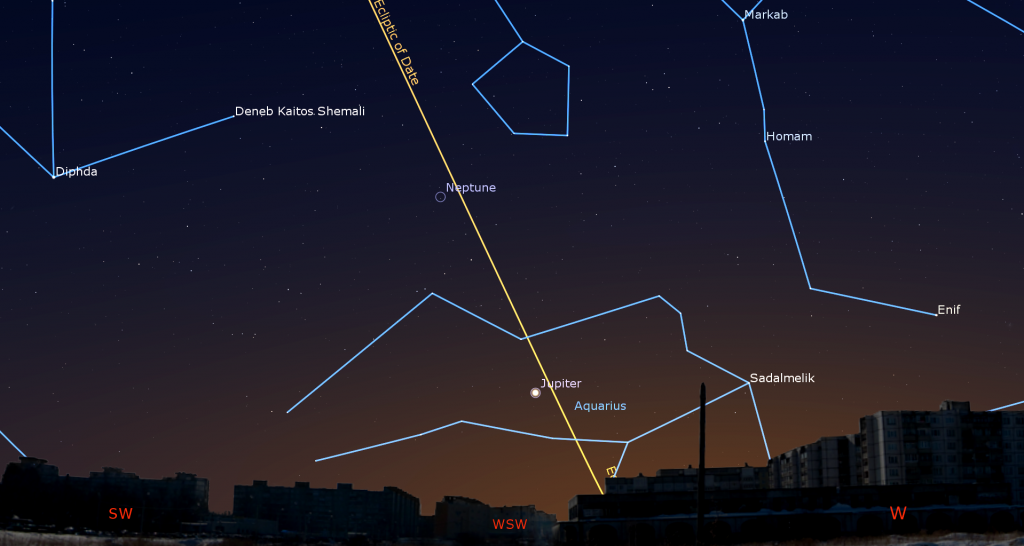
The blue planet Neptune is following Jupiter sunward. The distant, dim planet is near the border between Aquarius (the Water-Bearer) and western Pisces (the Fishes), about 1.3 fist diameters to the upper left (or 13° to the celestial east) of Jupiter. Early this week, before the moon gets too bright, Neptune might be seen in good binoculars and backyard telescopes. To locate it, use binoculars to find the sloped grouping of five medium-bright stars: Psi (a triple star), plus Chi, and Phi Aquarii (or ψ, X, and φ Aqr). Neptune’s non-twinkling speck will sit several finger widths above (or 3 degrees to the celestial ENE) of the top star, Phi. Viewed in a telescope, Neptune’s apparent disk size will be 2.2 arc-seconds. Try to view Neptune immediately after dark, while it sits higher in the sky. It’ll be tough to find by 6:30 pm local time.
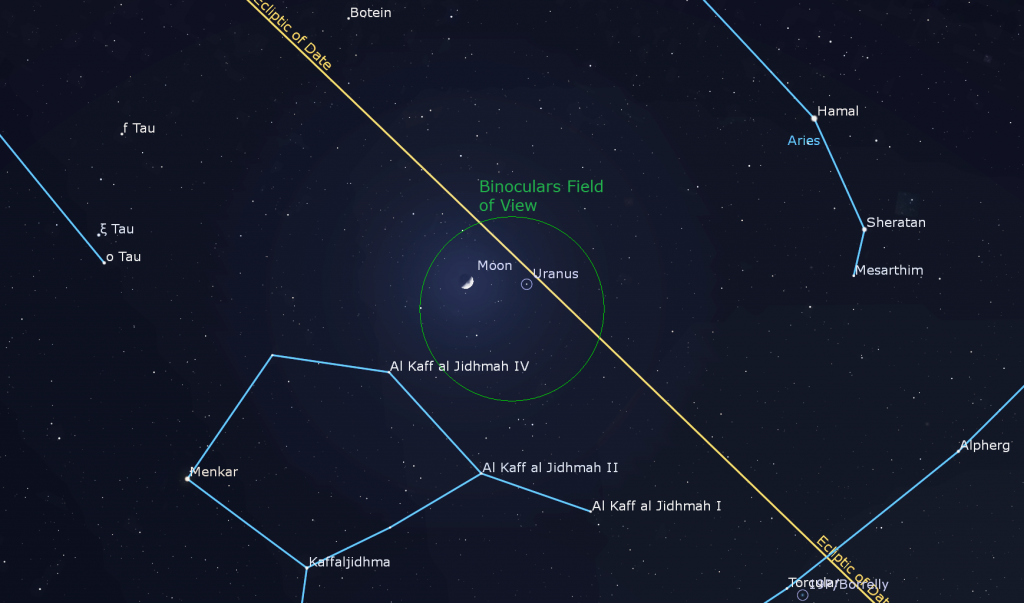
At a much brighter magnitude +5.8, Uranus can usually be seen easily in binoculars and backyard telescopes – and even with your unaided eyes. As I mentioned above, the moon will pass near Uranus on Monday night. Without the moon around, look for the planet’s small dot positioned a fist’s width to the lower left of (or 11.5 degrees to the celestial southeast of) Aries’ brightest stars, Hamal and Sheratan. In fact, it’s almost exactly midway along a line connecting Hamal with the bright star Menkar in Cetus. Uranus is also about two fist diameters to the upper right (or 19 degrees to the celestial west-southwest) of the Pleiades star cluster. This week Uranus will be observable until about mid-evening – especially around 7 pm local time, when it will still sit more than halfway up the southern sky.
Early risers can see brilliant Venus gleaming low in the southeastern sky between 5 am and dawn this week. On Saturday, Venus will officially reach its greatest illuminated extent for its current morning apparition. In a telescope, the planet will show a 26%-illuminated, waxing crescent phase and an apparent disk size of 41 arc-seconds. Even with a less than fully-illuminated disk, Venus’ distance from Earth of only 0.413 Astronomical Units (61.78 million km) will boost its brightness to a brilliant magnitude -4.86. After rising at about 4:50 am local time, Venus will be visible in the southeastern pre-dawn sky near the teapot-shaped constellation of Sagittarius. Venus will appear nearly as bright on Friday and Sunday.
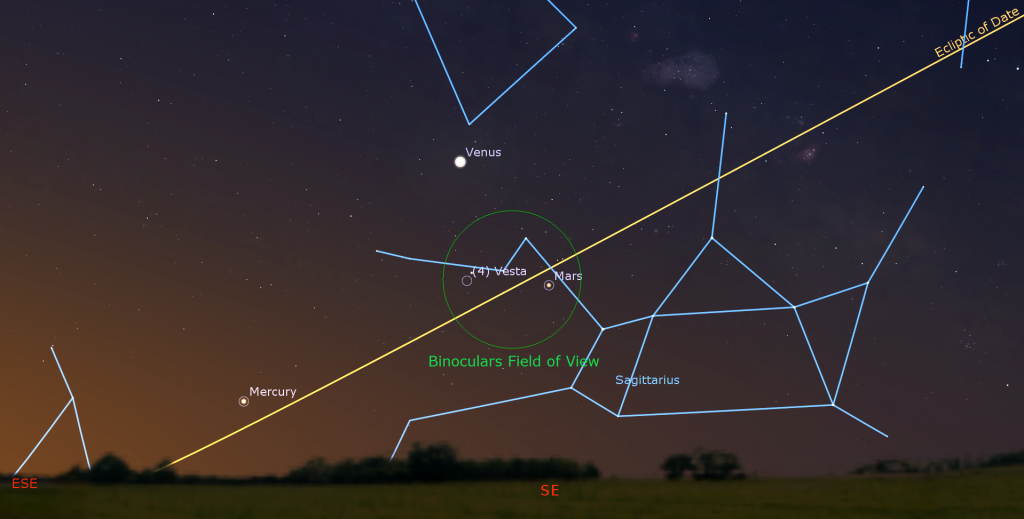
300 times fainter Mars will be rising about half an hour later than Venus. Look for and the reddish planet sitting a generous palm’s width to Venus’ lower right (or 7.5° to the celestial south) before the sky brightens too much. Both planets will be travelling westward, on gradually converging parallel tracks, for some time to come – but they’ll still be slowly increasing their angle from the sun. The minor planet designated (4) Vesta will stay a few finger widths to Mars’ left.
The speedy planet Mercury will be pulling away from the sun this week. After it rises, at about 6 am local time, you can spot the medium-bright planet shining 1.2 fist diameters to the lower left of Mars and Venus.
Wending the Winter Milky Way
If you missed last week’s tour of the Winter Milky Way, I posted it here.
Public Astro-Themed Events
Every Monday evening, York University’s Allan I. Carswell Observatory runs an online star party – broadcasting views from four telescopes/cameras, answering viewer questions, and taking requests! Details are here. Their in-person Wednesday night viewing has been converted to online via the observatory YouTube channel.
On Wednesday afternoon, February 9 at 2 pm EST, the Ontario Science Centre will live stream on YouTube a free, public session all about the James Webb space Telescope. Details are here.
From Thursday, February 10 at 6:30 pm EST to Saturday, February 12 at 10 pm EST, the Astronomy & Space Exploration Society (ASX) will stream their Annual Symposium entitled Stellar Spectacles: Peering into the Cosmos with Telescopes, Neutrino Detectors, and Gravitational Waves. Details and the Eventbrite registration link are here.
Public sessions at the David Dunlap Observatory may not be running at the moment, but we are pleased to offer some virtual experiences instead in partnership with Richmond Hill. The modest fee supports RASC’s education and public outreach efforts at DDO.
On Friday night, February 11 from 7:30 to 9:00 pm EDT, the DDO Astronomy Speakers Night program will feature Dr. Saeed Rastgoo, assistant professor at York University. He’ll speak on Black Holes: What We See On the Outside, What Happens Inside. There will also be a virtual tour of the DDO and live-streamed views from the DDO’s 74-Inch telescope (weather permitting). Only one registration per household is required. Deadline to register for this program is Wednesday February 9, 2022 at 3 pm. More information is here and the registration link is here.
On Sunday afternoon, February 13 from 12:30 to 1 pm EST, tune in for DDO Sunday Sungazing. Safely observe the sun with RASC, from the comfort of your home! During these family-friendly sessions, a DDO Astronomer will answer your questions about our closest star: the sun! Learn how the sun works and how it affects our home planet. Live-streamed views of the sun through small telescopes will be included, weather permitting. Only one registration per household is required. Deadline to register for this program is Wed., February 9, 2021 at 3 pm. Prior to the start of the program, registrants will be emailed the virtual program links. More information is here and the registration link is here.
My free, family-friendly Insider’s Guide to the Galaxy webcasts with Samantha Jewett of RASC National return on Tuesday, February 15 at 3:30 pm EST, when we’ll welcome special guests to talk about indigenous astronomy, and we’ll continue with our Messier Objects observing certificate program. You can find more details and the schedule of future sessions here.
Don’t forget to take advantage of the astronomy-themed YouTube videos posted by RASC Toronto Centre and RASC Canada.
Space Station Flyovers
The ISS (or International Space Station) is not visible over the GTA this week.
Keep looking up, and enjoy the sky when you do. I love questions and requests. Send me some!